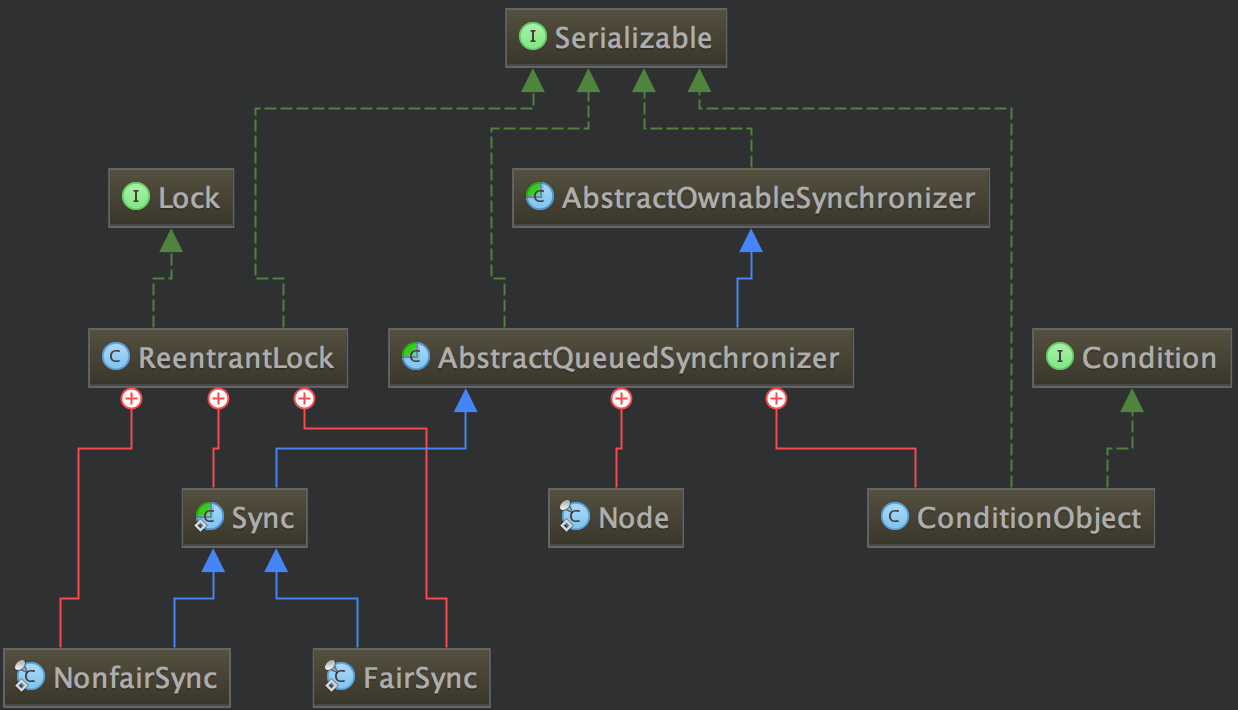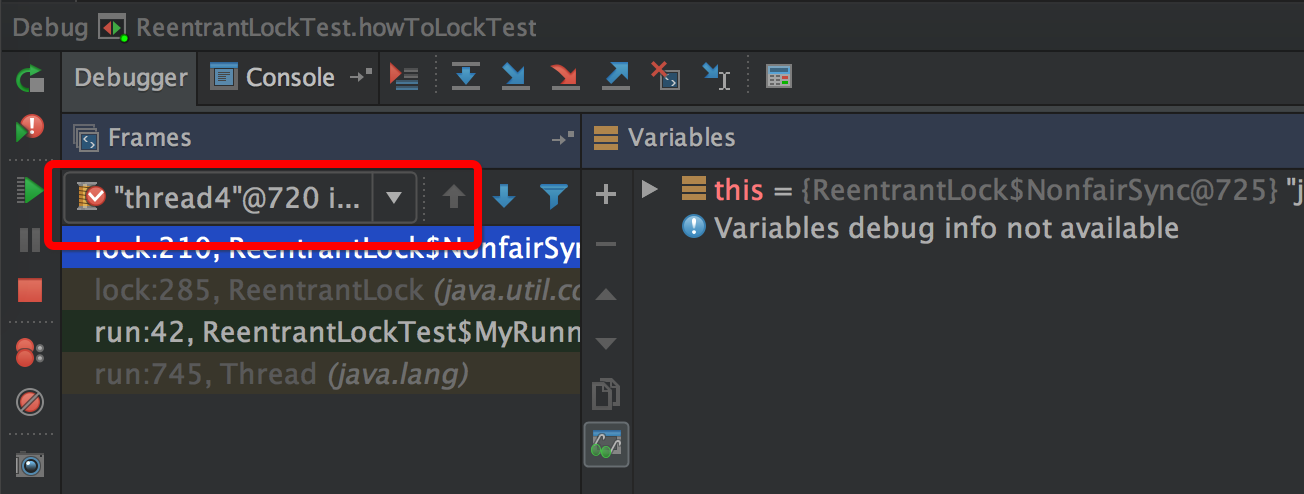ReentrantLock源码解析
概述
ReentrantLock的结构体如下

- 内部类
Sync继承自AbstractQueuedSynchronizer参见aqs - Sync两个子类
NonfairSync实现非公平锁、FairSync实现公平锁 - 使用AQS的独占API
非公平锁
idea debug多线程,将断点设置为线程级别就可以了,如下图所示

然后在debug时,在这里切换线程

设置以下几个断点

本文使用的例子
// 1.线程1首先拿到锁,但不释放锁呢。
// 2.线程2,3,4依次入等待队列
// 3.线程4自旋一次,会将pred的waitStatus改为signal,观察线程3释放锁时的unparkSuccessor操作。
@Test
public void howToLockTest() throws InterruptedException {
ReentrantLock lock = new ReentrantLock();
new Thread(new MyRunnable(lock), "thread1").start();
Thread.sleep(100);
new Thread(new MyRunnable(lock), "thread2").start();
new Thread(new MyRunnable(lock), "thread3").start();
new Thread(new MyRunnable(lock), "thread4").start();
Thread.sleep(1000000000);
}
private class MyRunnable implements Runnable {
private ReentrantLock lock;
MyRunnable(ReentrantLock lock) {
this.lock = lock;
}
@Override
public void run() {
lock.lock();
try {
Thread.sleep(1000);
} catch (InterruptedException e) {
e.printStackTrace();
} finally {
lock.unlock();
}
}
}
加锁过程
NonfairLock#lock
ReentrantLock#lock() -> NonfairLock#lock()
// 执行加锁,立即闯入,如果失败的话执行正常的acquire
final void lock() {
// CAS操作保证操作的原子性
// state声明为 volatile保证内存可见性,state=0表明可以争用。
// 非公平的,刚进来就大家随便争,可以对比下公平锁的lock这里怎么搞的。
if (compareAndSetState(0, 1))
// 如果state 0->1设置成功,设置当前线程为同步器的属主线程
setExclusiveOwnerThread(Thread.currentThread());
else
acquire(1);
}
线程1因为比线程2,3,4执行提前0.1s,所以肯定走不到else分支, 因为线程1拿到锁之后并不释放锁,所以线程2,3,4肯定走else分支,acquire(1)
AQS#acquire
// 尝试获取锁,获取不到则创建一个waiter(当前线程)后放到队列中
public final void acquire(int arg) {
// 以独占模式acquire失败
if (!tryAcquire(arg) &&
// 包装一个当前线程的Node,入队列,然后尝试去acquire
acquireQueued(addWaiter(Node.EXCLUSIVE), arg))
// 如果该线程被中断了,中断当前线程
selfInterrupt();
}
Sync#nonfairTryAcquire
NonfairSync#tryAcquire(arg) -> Sync#nonfairTryAcquire(arg)
final boolean nonfairTryAcquire(int acquires) {
final Thread current = Thread.currentThread();
int c = getState();
// 获取state标志位,如果为0,没有线程持有锁
if (c == 0) {
// CAS尝试去获取锁。
if (compareAndSetState(0, acquires)) {
// 如果获取成功,设置属主线程为当前线程。
setExclusiveOwnerThread(current);
return true;
}
}
// 如果不为0,判断当前线程是否为属主线程,这里实现可重入
else if (current == getExclusiveOwnerThread()) {
int nextc = c + acquires;
if (nextc < 0) // overflow
throw new Error("Maximum lock count exceeded");
// 设置state的值,state的值表明当前线程的重入数。
setState(nextc);
return true;
}
return false;
}
如果tryAcquire失败,把当前线程包装为一个Node入队列,并再次尝试acquire
包装当前线程为一个node
AQS#addWaiter
AbstractQueuedSynchronizer#addWaiter()
private Node addWaiter(Node mode) {
Node node = new Node(Thread.currentThread(), mode);
// Try the fast path of enq; backup to full enq on failure
Node pred = tail;
// 如果队列不为空
if (pred != null) {
// node的先驱节点设置为tail
node.prev = pred;
// 设置当前节点为tail
if (compareAndSetTail(pred, node)) {
// 原有的tail的后继节点指向node
pred.next = node;
return node;
}
}
// 如果pred为null,说明之前队列为空,执行enq方法,自旋方式入队列
// 或者设置当前节点为tail失败,表明有别的线程并发入队列,执行enq方法,自旋方式入队列。
enq(node);
return node; }
AQS#enq
AbstractQueuedSynchronizer#enq()
private Node enq(final Node node) {
// 自旋方式入队列
for (;;) {
Node t = tail;
// !!!!重要
// 如果队列为空,初始化head和tail节点
if (t == null) { // Must initialize
if (compareAndSetHead(new Node()))
tail = head;
} else {
// 如果队列不为空,将该节点的前驱节点设置为tail,
node.prev = t;
// 同时cas设置tail为node,如果设置失败,说明有并发修改tail
if (compareAndSetTail(t, node)) {
// 设置tail的后继节点为node
t.next = node;
return t;
}
}
}
}
入队列后,然后尝试从队列中acquire
AQS#acquireQueued
AbstractQueuedSynchronizer#acquireQueued()
final boolean acquireQueued(final Node node, int arg) {
boolean failed = true;
try {
boolean interrupted = false;
for (;;) {
final Node p = node.predecessor();
// 如果先驱节点为head,尝试acquire
if (p == head && tryAcquire(arg)) {
// acquire成功,将head节点置为node
setHead(node);
p.next = null; // help GC
failed = false;
return interrupted;
}
// 如果先驱节点不是head,或者是head,但是尝试acquire失败
if (shouldParkAfterFailedAcquire(p, node) &&
parkAndCheckInterrupt())
interrupted = true;
}
} finally {
if (failed)
cancelAcquire(node);
}
}
AbstractQueuedSynchronizer#setHead()
private void setHead(Node node) {
head = node;
// 头节点不绑定线程
node.thread = null;
node.prev = null;
}
AQS#shouldParkAfterFailedAcquire
/** waitStatus value to indicate thread has cancelled */
// 当前线程已经被取消
static final int CANCELLED = 1;
/** waitStatus value to indicate successor's thread needs unparking */
// 后继节点线程等待被触发
static final int SIGNAL = -1;
/** waitStatus value to indicate thread is waiting on condition */
// 线程等待条件
static final int CONDITION = -2;
/**
* waitStatus value to indicate the next acquireShared should
* unconditionally propagate
*/
// 节点状态需要向后传播
static final int PROPAGATE = -3;
private static boolean shouldParkAfterFailedAcquire(Node pred, Node node) {
int ws = pred.waitStatus;
if (ws == Node.SIGNAL)
/*
* This node has already set status asking a release
* to signal it, so it can safely park.
*/
// 只有当前节点的前一个节点为SIGNAL时,当前节点才能被挂起
return true;
if (ws > 0) {
/*
* Predecessor was cancelled. Skip over predecessors and
* indicate retry.
*/
do {
node.prev = pred = pred.prev;
} while (pred.waitStatus > 0);
pred.next = node;
} else {
/*
* waitStatus must be 0 or PROPAGATE. Indicate that we
* need a signal, but don't park yet. Caller will need to
* retry to make sure it cannot acquire before parking.
*/
compareAndSetWaitStatus(pred, ws, Node.SIGNAL);
}
return false;
}
解锁过程
解锁过程较简单点
AbstractQueuedSynchronizer#release
ReentrantLock#unlock() -> AbstractQueuedSynchronizer#release()
public final boolean release(int arg) {
if (tryRelease(arg)) {
Node h = head;
// 属主线程可能是head节点也可能不是head节点哟。
if (h != null && h.waitStatus != 0)
// 如果是head节点,并且waitStatus不为0(SIGNAL、CONDITION、PROPAGATE),则唤醒后继节点。
unparkSuccessor(h);
return true;
}
return false;
}
ReentrantLock#tryRelease
protected final boolean tryRelease(int releases) {
int c = getState() - releases;
if (Thread.currentThread() != getExclusiveOwnerThread())
throw new IllegalMonitorStateException();
boolean free = false;
// 可重入,只有减为0时,才是free,别的线程才能抢得到。
if (c == 0) {
free = true;
// 设置属主线程为null
setExclusiveOwnerThread(null);
}
setState(c);
return free;
}
AQS#unparkSuccessor
private void unparkSuccessor(Node node) {
/*
* If status is negative (i.e., possibly needing signal) try
* to clear in anticipation of signalling. It is OK if this
* fails or if status is changed by waiting thread.
*/
// 如果状态是负的(例如,可能等待着被signal)
int ws = node.waitStatus;
if (ws < 0)
compareAndSetWaitStatus(node, ws, 0);
/*
* Thread to unpark is held in successor, which is normally
* just the next node. But if cancelled or apparently null,
* traverse backwards from tail to find the actual
* non-cancelled successor.
*/
Node s = node.next;
if (s == null || s.waitStatus > 0) {
s = null;
for (Node t = tail; t != null && t != node; t = t.prev)
if (t.waitStatus <= 0)
s = t;
}
if (s != null)
LockSupport.unpark(s.thread); }
公平锁
加锁过程
整体流程和非公平加锁是一样的。
FairLock#lock
final void lock() {
// if (compareAndSetState(0, 1))
// setExclusiveOwnerThread(Thread.currentThread());
// else
// 必须严格按照队列顺序来
acquire(1);
}
FairSync#tryAcquire
protected final boolean tryAcquire(int acquires) {
final Thread current = Thread.currentThread();
int c = getState();
if (c == 0) {
// 比非公平加锁,多了这个判定条件 hasQueuedPredecessors,必须没有前驱节点才让你acquire,否则的话,好好等着,轮到你再来。
if (!hasQueuedPredecessors() &&
compareAndSetState(0, acquires)) {
setExclusiveOwnerThread(current);
return true;
}
}
else if (current == getExclusiveOwnerThread()) {
int nextc = c + acquires;
if (nextc < 0)
throw new Error("Maximum lock count exceeded");
setState(nextc);
return true;
}
return false;
}
解锁过程和非公平锁是一样一样的。
参考
[x86的指令集]http://www.felixcloutier.com/x86/
[AQS,老爷子的论文]http://gee.cs.oswego.edu/dl/papers/aqs.pdf
[AbstractQueuedSynchronizer的实现分析(上)]http://www.infoq.com/cn/articles/jdk1.8-abstractqueuedsynchronizer
[AbstractQueuedSynchronizer的实现分析(下)]http://www.infoq.com/cn/articles/java8-abstractqueuedsynchronizer

